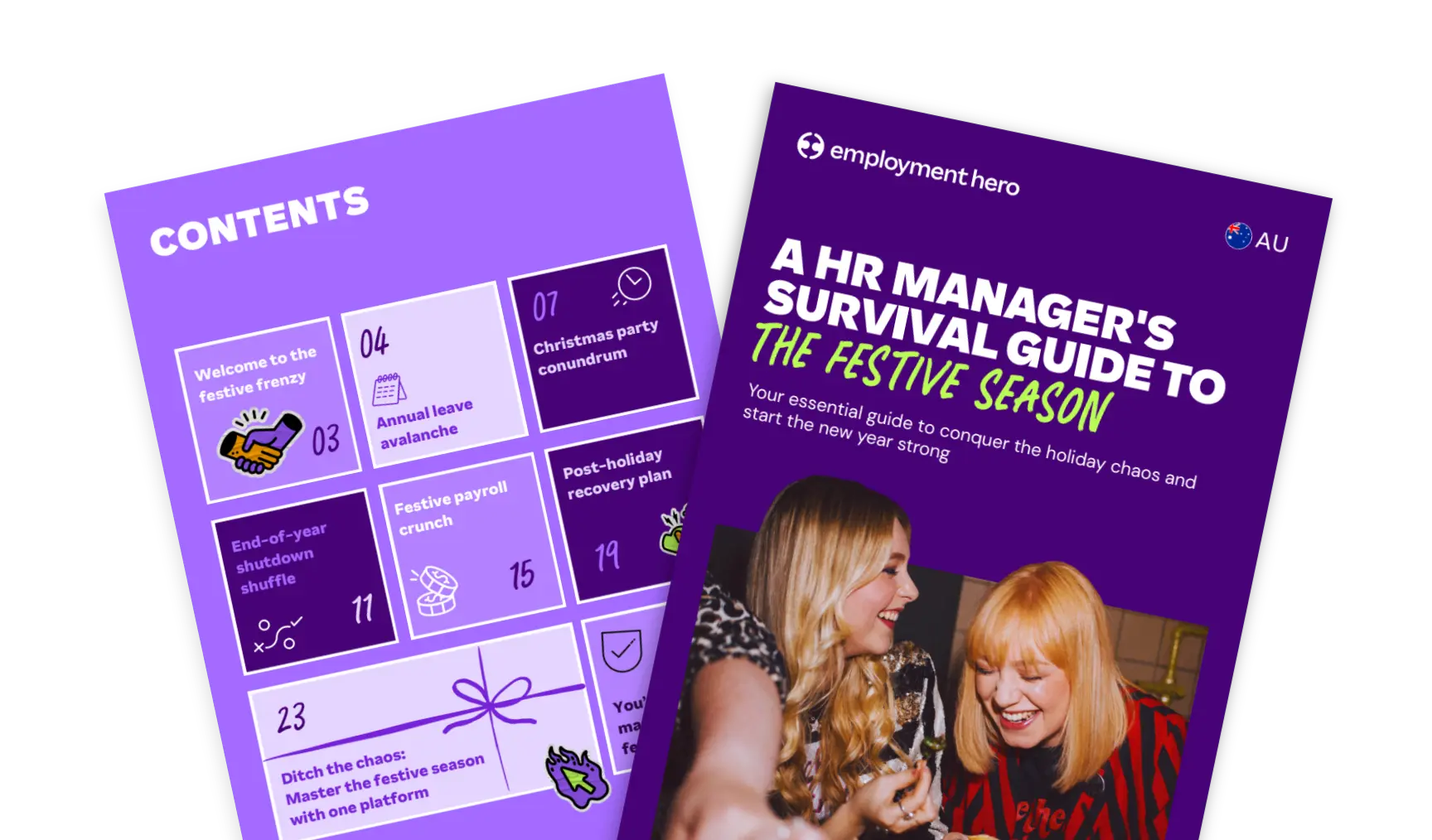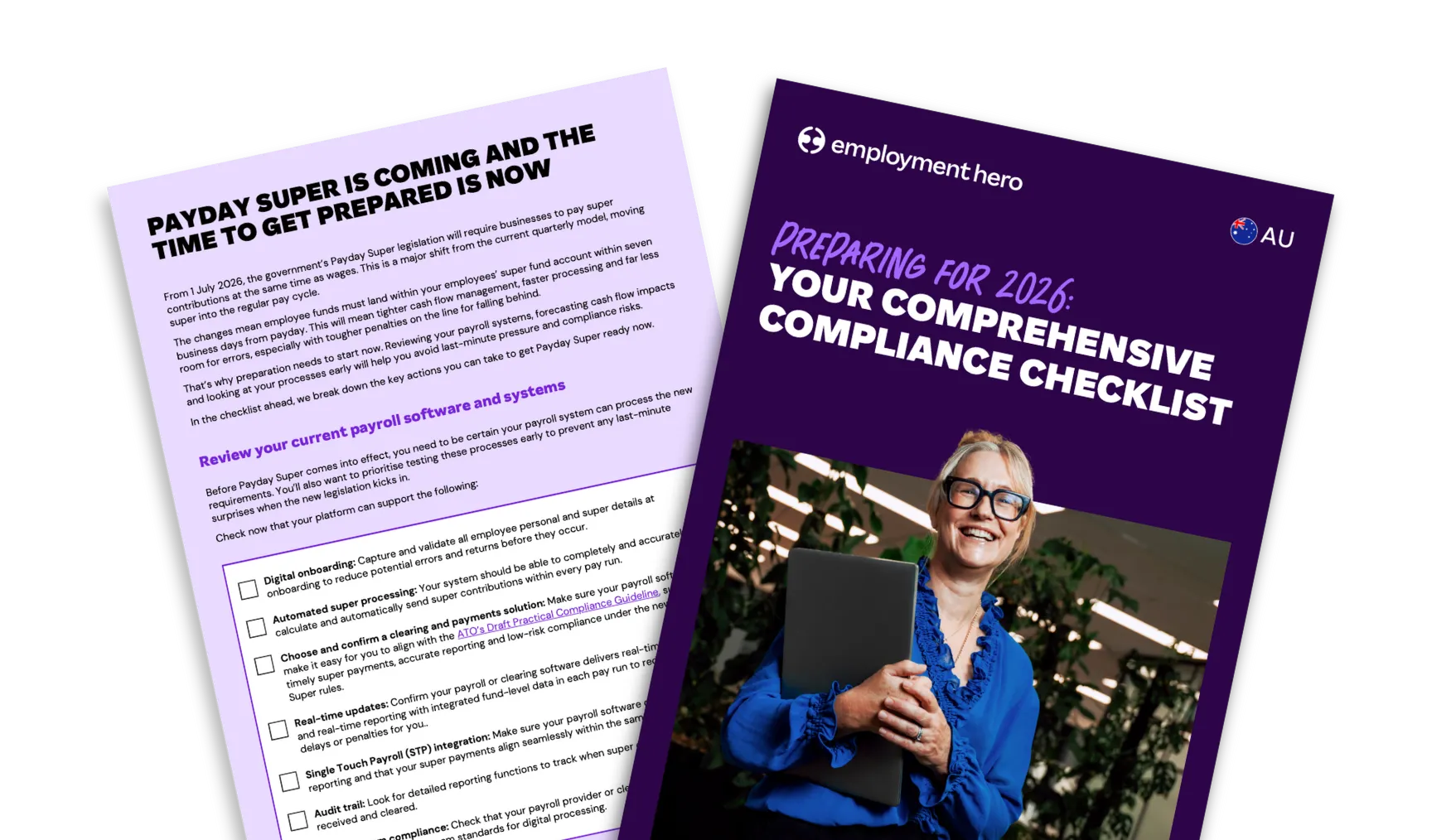Holiday rostering best practices for Australian employers
Published
Holiday rostering best practices for Australian employers
Published
As the year winds down, most Australians are busy planning beach trips and family gatherings. But for business owners and managers, the festive season often brings a different kind of challenge. Increased customer demand, overlapping leave requests and a string of public holidays can quickly turn December into a holiday headache.
How you manage your holiday roster can make all the difference. It could be the key to a smooth, profitable season or a costly hit to your bottom line. Getting it right means balancing your team’s needs with business demands, all while keeping everyone feeling supported and ready to deliver.
If this time of year has you feeling more frazzled than festive, we’ve got you. This guide will help you build a strong, effective roster that takes the stress out of summer and keeps your business running like clockwork.
Download the holiday rostering guide now by filling in the form on the right.
What is in this holiday rostering guide?
Here’s what you’ll find inside:
- How to use technology and forecasting to stay ahead
- The real challenges behind holiday rostering (and how to overcome them)
- Understanding your legal obligations
- Building and managing the ideal holiday roster
- Pro tips for handling staff shortages and unexpected absences

Things to consider when rostering during the holidays
Anyone who’s ever managed a holiday roster knows that it’s a delicate balancing act.
Make the wrong decision and you risk spiralling costs, employee burnout, missed sales and HR compliance headaches. Get it right and you could drive record-breaking sales and huge profits.
Here are some important things to consider when planning your roster for the holiday season.
Rostering fairly and compliantly
Half the battle when creating a winning holiday roster is knowledge, especially when it comes to compliance. If you manage holiday rostering without having a strong grip on your legal obligations, it could spell disaster further down the line. Here’s the top three areas you need to consider:
- Managing your workforce effectively, including entitlements of casuals and permanent staff
- Understanding public holidays and pay rates
- Knowing the mandatory breaks and other entitlements under different modern awards
Confused about compliance? Get in touch with our HR Advisory team who can review your current processes and work with you to make sure you’ve got everything covered legally.
Download the full guide and learn more about holiday rostering compliance.
Common risks to avoid
Managing holiday rosters can be a balancing act. While it’s essential to meet business demands, it’s equally important to manage compliance and keep your employees happy. Poor rostering decisions during this period can lead to compliance breaches, burnout or even a loss of trust among your team.
Overworking your staff
One major risk during the holiday period is overworking your staff. It can be tempting to rely on the same high-performing employees to cover multiple public holidays, but this approach can quickly backfire if they become burnt out. Be mindful of rotating holiday shifts fairly and giving everyone adequate rest periods.
Ignoring employee availability
Another common issue is ignoring employee availability. Overlooking an employee’s pre-disclosed leave or availability not only causes frustration, but can also lead to compliance concerns under workplace laws.
To avoid this, introduce and communicate a clear, transparent system for staff to share their availability well in advance. Make it easy for employees to request time off and make sure managers review and acknowledge these requests before finalising the roster.
Poor communication
Simply publishing a roster and assigning someone to work on Christmas Day or Boxing Day without any prior discussion sends the wrong message and could be a breach of workplace laws.
Instead, you should communicate holiday shifts as reasonable requests, not assumptions. Let employees know why coverage is needed, ask for volunteers where possible and always be open to a conversation about individual circumstances.
Inadequate record keeping
One final challenge to watch out for is inadequate record-keeping. During the busy holiday period, it’s easy to lose track of who’s accepted shifts, who’s declined and whether employees have been fairly compensated for working on public holidays.
Without accurate records, businesses risk non-compliance or facing disputes over pay and entitlements. This is why it’s so important to keep detailed records of all roster communications, timesheets, shift approvals and worked hours. Using reliable HR software or rostering software can simplify this process by creating a clear digital trail, while making sure your team is paid correctly for every shift.istakes and manage psychosocial hazards effectively.

Can employees be required to work on a public holiday?
Under the Fair Work Act, employers can request that an employee work on a public holiday, but employees also have the right to refuse if their refusal is reasonable. The key is to make sure everyone understands that these shifts are requests, not directives.
It’s important to be aware that there is a critical distinction. An employer cannot unilaterally require an employee to work. It must be a formal request and the employee has the right to refuse if their refusal is reasonable.
How can employers clarify that a rostered day on a public holiday is a request?
Simply publishing a roster and expecting it to be final isn’t enough. Be proactive in how you communicate and be clear with your intentions from the start. When sharing the roster, include a note such as:
“This roster includes shifts on a public holiday. Please note that these shifts are a request. If you have any concerns or wish to decline, please discuss them with your manager.”
It’s also good practice to follow up individually. For any employee rostered on a public holiday, send a quick message or email saying something along the lines of:
“Hi [employee name], we’ve requested you to work on [public holiday]. Please let us know if you’re available or if you’d prefer not to work this shift.”
This reinforces that participation is a choice and gives employees a clear channel to respond.
Holding a short team meeting before finalising the roster can also help. Use this time to explain business needs, discuss coverage options and invite volunteers where possible.
Finally, consider using HR or rostering software (like Employment Hero) to send digital shift requests that employees can accept or decline. This not only simplifies communication but also creates a clear record of the request and response.
Can contracts include a term requiring public holiday work?
Some employment contracts or enterprise agreements may include a clause stating that employees may be required to work on public holidays as part of their ordinary hours. While these clauses are common, they don’t give an employer the unlimited right to demand work.
Even with such a term in an employment agreement, any requirement to work on a public holiday must still be framed as a reasonable request. The employee retains the right to a reasonable refusal.
These contractual terms simply establish an expectation that public holiday work may be a part of the role, but they don’t override the fundamental principles of the Fair Work Act. It’s crucial that employment contracts are drafted carefully to reflect this balance.

When is a request or refusal considered reasonable?
The Fair Work Act outlines several factors to determine if an employer’s request or an employee’s refusal is reasonable. There is no single answer, as each situation is assessed individually.
Some factors to consider when looking at whether a request or refusal is reasonable include:
- The nature of the employer’s workplace and its operational requirements.
- The employee’s personal circumstances, including family responsibilities.
- Whether the employee is entitled to receive overtime payments, penalty rates or other compensation.
- The role and type of employment (e.g. full-time, part-time or casual).
- The amount of notice given by the employer when making the request.
- The amount of notice given by the employee when refusing.
For example, an employee’s refusal to work on Christmas Day due to family responsibilities would likely be considered a reasonable refusal. Conversely, if an employee in a critical role at a 24/7 business refuses with little notice, their refusal may be deemed unreasonable.
Download the holiday rostering guide
Staying on top of your rostering obligations during the holiday season doesn’t have to be a struggle. Arm yourself with the right knowledge, as well as time and attendance tools, to manage your workforce effectively. Our comprehensive holiday rostering guide provides the essential information you need to build an effective holiday roster.
Download your free holiday rostering guide today and take control of your employment obligations.
Disclaimer: The information in this guide is current as at 20 October 2025, and has been prepared by Employment Hero Pty Ltd (ABN 11 160 047 709) and its related bodies corporate (Employment Hero). The views expressed are general information only, are provided in good faith to assist employers and their employees, and should not be relied on as professional advice. The Information is based on data supplied by third parties. While such data is believed to be accurate, it has not been independently verified and no warranties are given that it is complete, accurate, up to date or fit for the purpose for which it is required. Employment Hero does not accept responsibility for any inaccuracy in such data and is not liable for any loss or damages arising either directly or indirectly as a result of reliance on, use of or inability to use any information provided in this guide. You should undertake your own research and seek professional advice before making any decisions or relying on the information in this guide.
Register for the guide
Related Resources
-
 Read more: HR Managers: Don’t just survive the festive season, master it
Read more: HR Managers: Don’t just survive the festive season, master itHR Managers: Don’t just survive the festive season, master it
Make year-end easier: manage leave, payroll, parties and shutdowns with confidence. Get practical tips for Australian SMEs. Download the free…
-
 Read more: Preparing for 2026: Your Compliance Checklist
Read more: Preparing for 2026: Your Compliance ChecklistPreparing for 2026: Your Compliance Checklist
Get your business ready for the 1 July 2026 changes. See practical steps for Payday Super, cash flow planning and…
-
 Read more: Monthly business budget template for employers
Read more: Monthly business budget template for employersMonthly business budget template for employers
Plan your monthly income and expenses with our free monthly business budget template. Download today to track cash flow and…























